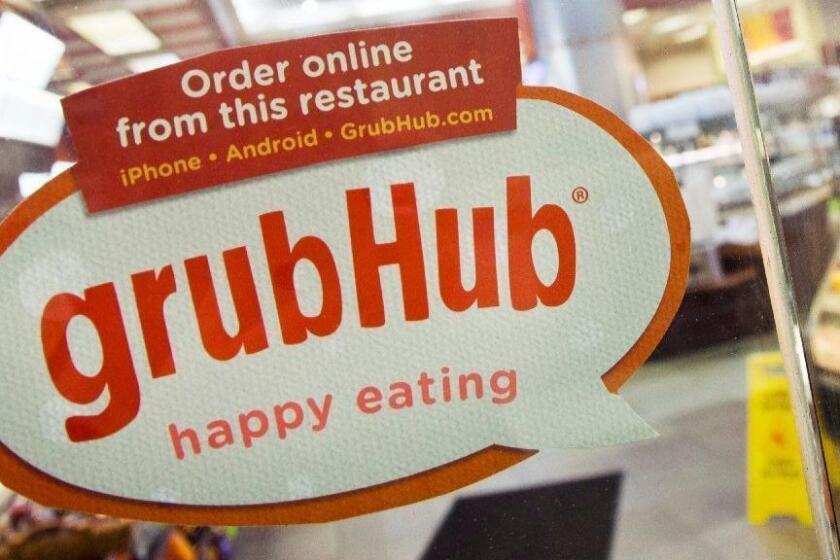How to use gig-economy jobs to change your life

Side hustles can change your life. Just ask Kevin Ha.
Last year, the income from Ha’s side hustles hit a point where the 33-year-old was able to quit his day job. He now replicates his working salary — more than $5,000 per month — working nights and weekends, while spending most days with his newborn.
“Now I work when I want and I do the things that I want to do,” says the Minneapolis lawyer, who blogs at FinancialPanther.com. “I still have to work for money. But I work much more on my own terms.”
Notably, about half of Ha’s monthly income comes from gig-economy apps that are widely available and do not require special skills. Unlike many other professionals who flock to highly paid consulting and teaching applications, Ha’s main side hustles involve delivery, surveys and room rentals.
Since the pandemic began, the bulk of his app-based income comes from food delivery platforms such as DoorDash, GrubHub and Uber Eats. Delivery apps like these have gone gangbusters since coronavirus-triggered business closures swept the country, Ha notes.
GrubHub is one of the better food delivery apps for drivers. It combines brisk demand with some pay guarantees and better-than-average delivery transparency.
That’s good for him because he temporarily dropped a formerly lucrative side hustle — renting out a spare bedroom through Airbnb — because he didn’t want to take any health risks with his new baby. Under more normal circumstances, the room rentals brought in about $1,000 a month.
However, the key to Ha’s success is not the apps he uses. It’s how he uses them. By being strategic about how he manages his side hustles, he earns far more per hour than most independent contractors. He typically takes home between $30 and $40 per hour, he says. That’s about twice the average hourly pay estimated for delivery drivers at SideHusl.com.
Ha has nine tips for using a side hustle to change your life.
1. Consider it a passion play
It starts with a little introspection. After all, you’ve got only 24 hours in a day, and 16 of those hours are likely to be used for sleep and your day job. That leaves just eight hours for everything else, including family, meals and entertainment.
If you’re going to fit a side hustle into those precious free hours, it better be something you like and want to be doing anyway, he says.
This is why Ha doesn’t tutor online. He could make a good hourly wage with sites like Wyzant, Wize and Varsity Tutors, since he can tackle complex topics such as preparing for the Law School Admissions Test. But he says he spends too many hours at his computer as it is. (His blog accounts for a significant portion of his income.)
Ha wants his app-based side hustles to involve activities he’d be doing with his free time — things such as riding his bicycle or walking his dog. That drew him to apps that let him make deliveries on his bike and to dog-walking and dog-watching apps such as Wag and Rover.
The remarkable thing about the rapid growth of the gig economy is there are part-time job options for people with a wide array of interests, including cooking, art, fixing things and writing. If you’re not sure what might suit your unique combination of interests, skills and resources, check out the SideHusl quiz.
2. Be in the business of you
Once you’ve picked the gig apps you want to work with, you need to train yourself to think like a business owner, Ha says.
The biggest mistake Ha sees people making is thinking like employees. Thus, when DoorDash or GrubHub asks them to take a delivery, they feel compelled to do it. After all, you rarely say no to your boss.
But when you are working with online platforms like these, you are generally considered an independent contractor. That means you’re in business for yourself and need to evaluate each offer as if it were a business deal, Ha says. If the proposed assignment provides enough money for your time and effort, accept. Otherwise, just say no.
“My acceptance rate for each of the apps is low — 10% to 40%,” he says. “I take the jobs that make business sense for me. I am not doing the ones that are not profitable.”
At one point, gig-economy companies would threaten to block workers who declined too many job offers, says Ha, who has been doing deliveries since 2015. But they rarely do that now.
That’s because many states are scrutinizing gig-economy companies to see whether they are better classified as employers, rather than — as the gig companies claim — software companies that facilitate self-employment. The more control the gig company has over your work, the more likely it is to be deemed an employer. Being designated employers would cost the gig companies a small fortune, so they’re less likely to press their luck in today’s environment.
“DoorDash will put your acceptance rate on the app, but it doesn’t mean anything,” says Ha, who specialized in employment law. “They are not going to kick you off the app for not accepting jobs.”
3. Trash the ‘scarcity mind-set’
Another reason that people accept unprofitable work is that they think they must in order to keep getting offered future work, Ha says.
“That’s a scarcity mind-set,” he says. “In reality, if you are in a big city, you are going to get a lot of offers. The world is a big place and there are a lot of people. There is always more out there for you.”
If the job requires too much driving or too much time for too little money, decline the request. You’ll get a better offer if you wait.
4. Seek on-the-way work
One of the ways that Ha has made delivery particularly lucrative is by using his delivery apps when he’s already on his bike. When he worked for a large law firm in downtown Minneapolis, for instance, he rode his bike to and from work. He would flip on his delivery apps as he was walking out of the office. (He’s signed up with six delivery apps: DoorDash, Uber Eats, GrubHub, Postmates, AmazonFlex and Roadie.) He’d scan them all to see if anyone needed a delivery that was on his way home.
“It was more therapeutic than it was just about money,” Ha says. “I was stressed at work, sitting 10 hours a day at a computer. I figured if I could spend an hour a day exploring the city while making deliveries on the way home, it was good for my mental health. And I was getting paid to exercise.”
5. Multitask
Since you are not an employee, you can work with as many apps as you want, Ha adds. The more apps you have, the more likely you can double or triple up with jobs that can be done on the same trip. Indeed, since food delivery apps often work with the same restaurants — or many restaurants in the same neighborhood — you may be able to pick up orders for DoorDash, Uber Eats and GrubHub all at the same time.
Getting multiple orders from different apps usually happens only during rush hours, however. That’s typically noon and after work. Doing deliveries at other hours is far less lucrative and less likely to be worth your time.
6. Watch expenses
Consider narrowing the geographic range where you work. Focus on just deliveries that are near your home or that are all near one another. That reduces the time it takes to pick up multiple deliveries, and it keeps gas and parking costs low for those doing deliveries with a car.
The Internal Revenue Service estimates that it costs 57.5 cents per mile to use your car for work. That figure includes the cost of gas and depreciation on your car. Your real costs could be somewhat different. But that’s a good guesstimate to use when you’re trying to figure out whether a delivery is worth your time.
7. Build your emergency fund
There’s nothing guaranteed about side-hustle income. Some months it’s great; other months, you’re hard-pressed to find work. If you hope to eventually work solely for yourself, you’ll need substantial emergency reserves.
When the pandemic struck, Ha says his income got slammed. But he has a year’s worth of emergency savings set aside. That made it easy not to worry about being able to pay day-to-day bills. He recommends that you build your emergency savings while you still have a day job, when your side-hustle income is just extra money.
How much do you need? Financial planners recommend that everyone set aside at least three to six months’ worth of living expenses. However, the more uncertain your circumstances or job, the more savings you need. If you’re the sole breadwinner and are fully self-employed, you may need as much as a year’s living expenses in savings.
8. Avoid lifestyle creep
A lot of people see side-hustle income as fun money. They use it to finance lavish vacations and to buy things they otherwise couldn’t afford.
That’s fine if you like your day job. But if your goal is to give yourself long-term freedom, you have to resist the urge to use this extra money for living expenses, says Ha. It makes earning enough to quit your day job far harder.
“I am not against spending money. Spend money on whatever you value,” he says. “But do it with your income. If you do it with this extra income, it means that you can’t afford it.”
9. Don’t forget the tax man
The other difference between being an employee and being self-employed is that no one automatically deducts taxes from your pay. So you need to set aside enough money from your earnings to pay state and local taxes, as well as levies for Social Security and Medicare. That’s likely to amount to 30% or more of what you earn.
Plan for that, so you don’t get unpleasantly surprised in April. But also know there are a number of deductions and credits that you can take as a self-employed person that you wouldn’t qualify for as an employee. The IRS has an entire section of its website dedicated to providing tax tips and help to gig-economy workers.
Kristof is the editor of SideHusl.com, an independent site that reviews hundreds of money-making opportunities in the gig economy.
More to Read
Inside the business of entertainment
The Wide Shot brings you news, analysis and insights on everything from streaming wars to production — and what it all means for the future.
You may occasionally receive promotional content from the Los Angeles Times.











